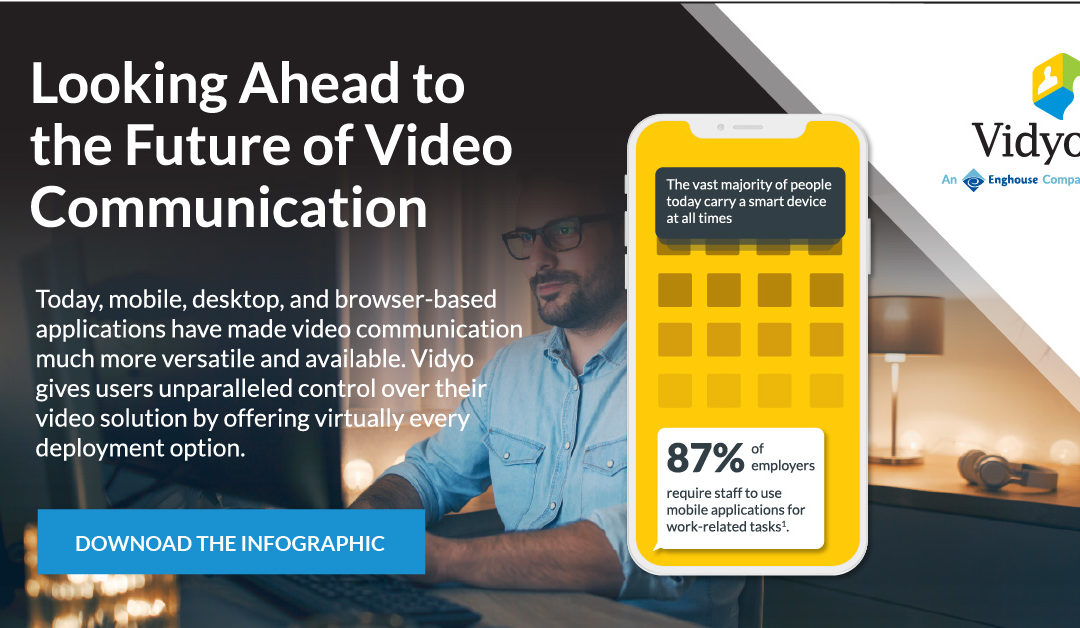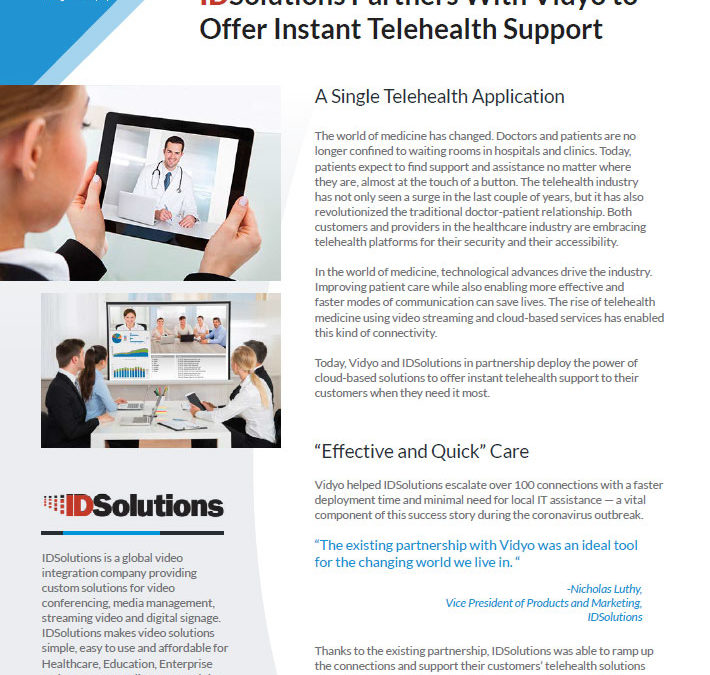


Looking Ahead to the Future of Video Communication Infographic

Look Ahead To The Future Of Video Communication

“In 2019, the video conferencing market was already valued at $3.85 billion — and this is expected to more than double by 2027.”
Against a backdrop of technology advancement, growing competition, and falling prices, advanced communication tools formerly reserved for large enterprises with deep pockets are now available to the masses. Nowhere has this been more clear than in the exploding use of video technology.
From telehealth consultations to digital classrooms and virtual events, video technology has near-unlimited use across applications in all industries. By making use of real-time two-way audio and visual communication, companies expect to reduce operational and management costs while boosting productivity. To help organizations learn how to benefit from integrating video technology, we cover the following topics in this blog:
- Key technology advancements for video communication
- Evolving workplace demographics and preferences
- Security with video communications
First, we’ll take a look at the evolution of this technology and its adoption.
Key Technology Advancements for Video Communication
It wasn’t so long ago that video conference technology was reserved for the boardrooms of Fortune 500 companies. Setups may have included dedicated cameras and screens installed in fixed conference rooms. Today, mobile, desktop, and browser-based applications have made video communication much more versatile and available.
Up to 90% of Fortune 500 companies are already using video conferencing in business communication. But technology development and diversification of the video market means organizations of every size and vertical can enjoy the benefit of high-quality video. Several technology factors have contributed to the deepening penetration of video solutions.
The rise of cloud-based solutions
According to McKinsey research, enterprise chief information officers consider cloud migration to be a primary means of realizing superior business results. As per McKinsey’s survey, 50 percent of enterprise workloads are already run via the cloud, and this is expected to increase to 75% by 2022. This is indicative of the drive for anytime-anywhere digital solutions.
With cloud-hosted video business communication solutions, not only can employees access systems and data while away from the office, but enterprises are no longer burdened by the cost of purchasing and maintaining onsite data centers. The same holds true for video conferencing solutions, many of which are now cloud-hosted and require no upfront hardware investment.
By entrusting video technology infrastructure and hosting to a third-party vendor, enterprises reap the benefit of purpose-built video call security and scalability, as well as service uptime which is typically guaranteed by the provider.
Universally compatible software
The second factor driving greater adoption of video technology is universally compatible software. In the past, video business communication solutions were sold as entire systems with software that ran on proprietary hardware or the hardware of a select manufacturer partner.
Today, the expectation is for out-of-the-box solutions that can easily integrate with existing IT infrastructure. With vendors increasingly focusing on offering either hardware or software, each has been able to improve product offerings to deliver more value to the enduser. Hardware vendors, for example, are improving cameras by offering 4K quality or AI-powered movement tracking capabilities. For their part, software vendors have sought to expand partnerships and offer more service features so their solution can be used with the customers’ chosen hardware and operating system. What’s more, some vendors offer the ability to integrate video communications into existing apps and workflows through a bit of code known as APIs.
These changes have empowered customers to find a best-fit solution without a prohibitive investment of time or capital.
“The vast majority of people today carry a smart device at all times, and up to 87% of employers require staff to use mobile applications for work-related tasks.”
Mobile solutions
With cloud-based applications and universally compatible software, the final piece of the anytime-anywhere puzzle is mobile technology. With mobile enterprise solutions, employees can access company systems, log reports, and share data from a smartphone, tablet, or another smart device. With mobile-friendly video conference apps, employees can also join video calls, access video knowledge bases, and even create and share new video content from anywhere with internet access.
In combination, these three technological advancements have created the ability for companies and their employees to use video technology to collaborate across geographies.

Evolving Workplace Demographics and Preferences
Ten thousand Baby Boomers reach retirement age every day — and Millennials already make up the largest cohort of the US working population. As the workforce gets younger, work culture and habits are changing too.
Both Millennials and Generation Z are digital natives who grew up with technology. Millennials and Gen Z are digitally savvy workers who:
- Are accustomed to instant access to information
- Expect swift communication through multiple platforms and devices
- Expect technology-powered training and support
- Prefer quick processes and frequent feedback
- Want independence to use creativity and thrive working in small teams
“According to a Microsoft and SurveyMonkey poll, 93% of Millennials consider having up-to-date technology an important factor when choosing a job.”
As younger workers advance in their careers, they have brought their digital skills and preferences into the workplace. They have become the driving force behind organizational digital transformation — and this has increasingly included the use of video conferencing in business communication to achieve clarity of objectives, speedy results, and flexible work scenarios.
Security with Video Business Communications
As organizations ramp up digital processes to adapt to new work realities, they face new challenges to secure data, digital workflows, and communications.
Cybercriminals are exploiting new digital vulnerabilities of work-from-home scenarios, and video communications are no exception. In fact, as video communication includes the exchange of voice, sounds, images, and files, there is a greater attack surface for cybercriminals. To protect video business communications, organizations need to train employees to secure their home office environments, use secure equipment and networks, follow best practices for video conferencing in business communication, and conduct vendor due diligence.
Employee training
Employee error and lax internal security practices are the most common factors that lead to a cyber breach. Training employees to secure their home work environments goes a long way in managing threats. Basic cybersecurity training for the home office should teach employees how to:
- Use WPA2 settings on home wi-fi routers
- Change all passwords, including those on the router
- Update and patch software on all devices used for work
- Protect personal and professional information
- Recognize phishing emails and suspicious links
Video call best practices
As an extension of home office cybersecurity training, every organization should set video call policies and best practices to mitigate threats. This includes:
- Using meeting gatekeeping protocols to keep uninvited guests out
- Protecting sensitive information shared on the call or in physical spaces in view of the camera
- Following predetermined criteria for recording and saving calls
Organization-level security
Organizations can also improve their security posture by providing employees with a secure environment to work in. This can include utilizing:
- Company-supplied devices with endpoint security installed
- Company-supplied VPNs to avoid relying on unsecured home or public networks
- An encryption standard of at least 128 bits to protect audio, video, and other files shared over networks
- Multi-factor authentication to access all business systems
Secure Deployment Options
With more organizations choosing to implement remote work options, security becomes a paramount concern. Some security issues that many organizations may overlook include data monetization, recorded meetings viewable on the web and meeting-bombing. One of the best solutions is deploying your video solution on a private instance to provide the highest level of control. This includes true on-premises, private cloud, and hybrid instances. Multitenant cloud also provides flexibility but with less controls for IT admin.
“One of the best solutions is deploying your video solution on a private instance to provide the highest level of control.”
Vendor due diligence
When it comes to secure video communication, the final piece of the equation is conducting vendor due diligence to find the right service provider. Vendors that value security have the requisite technology and policies to protect data and privacy. Vendor security factors to consider include:
- Built-in protections for secure access and call participant identity verification
- Partnerships with vetted and approved webservice providers
- Transparent privacy and data use policies
- Machine-to-machine encryption for endpoint and server communications
- Compliance with NIST guidelines and ISO 27001
- Compliance with GDPR, California Consumer Privacy Act, NYS SHIELD Act, and other relevant regulations

The Drive for Video Business Communication Transformation
As organizations find cost savings and improved productivity through digital processes, virtual work scenarios and video communication will remain — even after the public health crisis is resolved.
To survive these turbulent times and embrace the future of work, enterprises need to leverage the latest communication technology to connect their workforce.
VidyoConnect is a state-of-the- art video conferencing platform with unmatched quality, security and reliability. As opposed to security as a feature, the Vidyo platform is built with security at its core. We adhere to the highest security standards to protect the sensitive information of the organizations that rely on our service.
Vidyo’s ecosystem of partnerships and integrations enable our customers to embed high-quality video within existing tools and workflows. By enhancing collaboration with real-time video, Vidyo customers can maintain strategic alignment, make more informed decisions, and deliver superior business results.
Transforming your organization for the future of work is no easy task — it requires careful planning and trusted partners. Vidyo is here to help.
Could your organization benefit from secure, seamless video business communication? Contact us or visit us online to learn about VidyoConnect today.

IDSolutions

Recent Comments